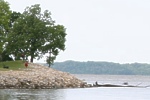MARK TWAIN NATIONAL WILDLIFE REFUGE
MARK TWAIN NATIONAL WILDLIFE REFUGE1704 No. 24th Street
Quincy, Illinois 62301
Phone:
217-224-8580Email:

The Mark Twain National Wildlife Refuge Complex (NWR) was established for the protection of migratory birds including waterfowl, shorebirds, and songbirds. It is located along the Mississippi Flyway, one of the major routes for migrating waterfowl. Refuge units also provide important habitat for big river fish and a variety of other native wildlife such as deer, fox, beaver, frogs, turtles, and snakes. Key goals are to conserve and enhance the quality and diversity of fish and wildlife and their habitats, to restore floodplain functions in the river corridor, and to provide wildlife-related recreational experiences for the public.
For centuries, the Upper Mississippi River and its floodplain have provided habitat for hundreds of fish and wildlife species. Over time, however, the natural river has been dramatically altered for navigation, flood control, agriculture and other human development, leaving fewer natural places for birds, fish, and other animals to live.
The lands and waters of the Mark Twain National Wildlife Refuge Complex provide fish and wildlife habitat along 350 miles of the Mississippi River corridor between Muscatine, Iowa and Gorham, Illinois. The 45,000 acres of wetland, open water, bottomland forest and grassland provide important habitat for the birds, fish and mussels, mammals, amphibians and reptiles that are native to this portion of the Upper Mississippi River. Unfortunately, many non-native invasive species are becoming established too.
Ducks, geese, shorebirds, and marsh and wading birds feed on wetland plants and invertebrates. Many fish species use wetland vegetation for feeding, refuge from predators, and spawning substrate. Turtles, salamanders, and snakes often depend on wetlands, too. Bottomland forests are used by migrating and nesting songbirds, waterfowl, hawks and eagles, herons and egrets, deer, small mammals, reptiles and amphibians. Grassland species such as the meadowlark, dickcissel, and grasshopper sparrow also benefit from our refuge management programs.
Several units within the Complex were established in the 1940?s following construction of the lock and dam system. Those units were consolidated into Mark Twain National Wildlife Refuge in 1958. Since then, other areas have been added to Mark Twain, which now includes 45,000 acres scattered along 345 miles of the Mississippi River and short distances up the Illinois and Iowa rivers. In 2000, Mark Twain NWR was split into five separate National Wildlife Refuges - Port Louisa NWR, Great River NWR, Clarence Cannon NWR, Two Rivers NWR, and Middle Mississippi River NWR. The Refuge Complex administration office, located in Quincy, IL, has retained the Mark Twain name.
The This link opens in a new windowUnited States Fish and Wildlife Service (Service) is an agency of the Department of the Interior. Our mission is working with others to conserve, protect and enhance fish and wildlife and their habitats for the continuing benefit of the American people.


